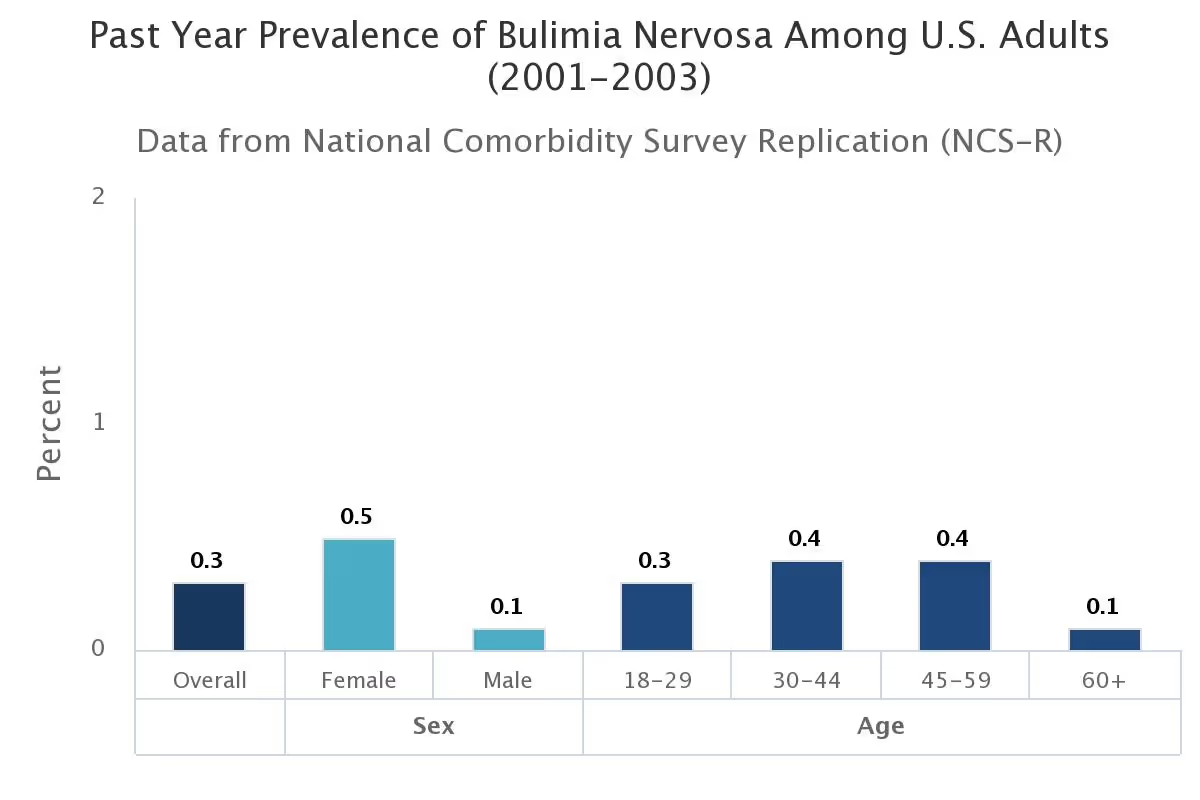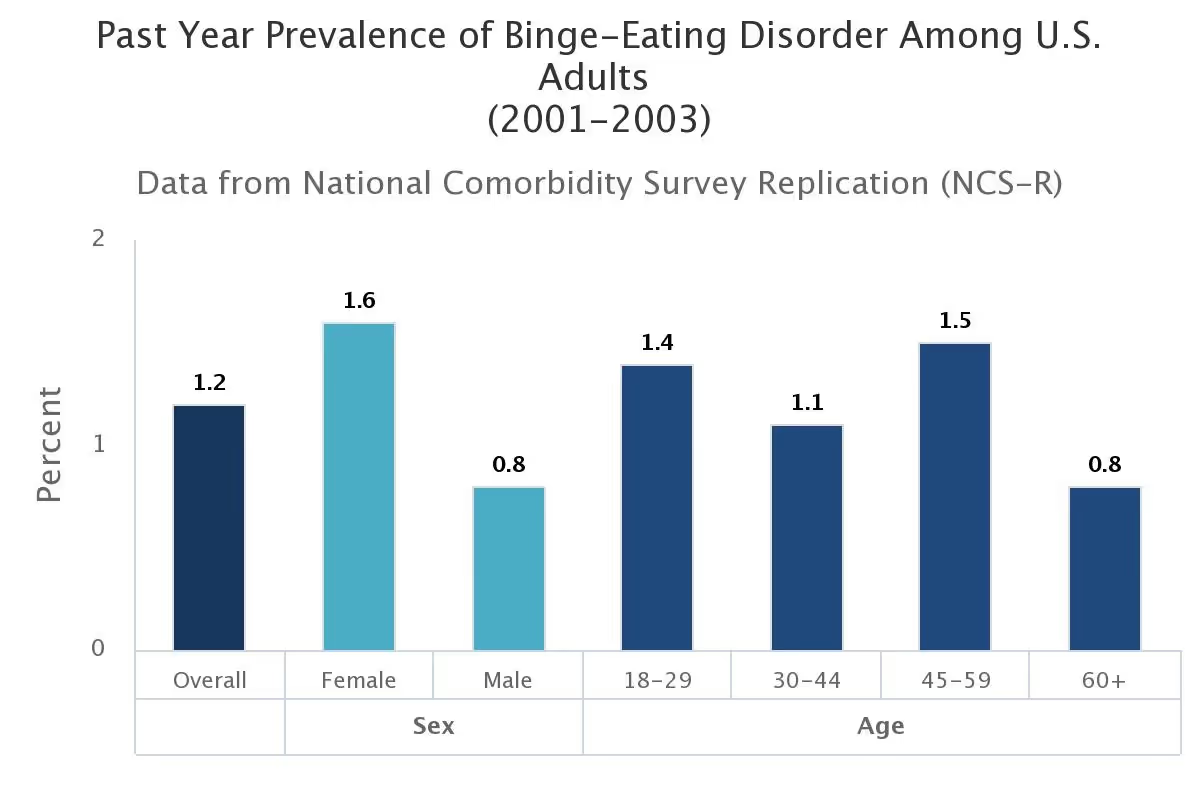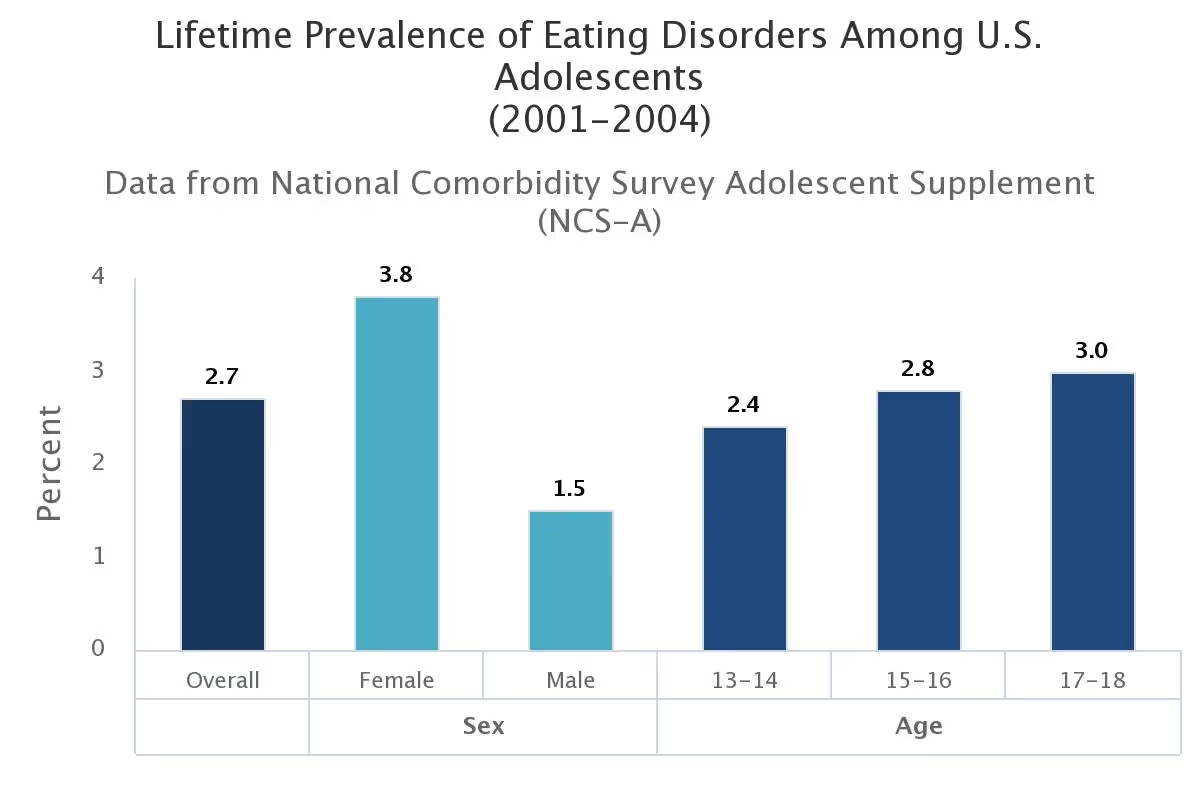37 Eating Disorder Statistics, Prevalence & Facts


How Many People Have Eating Disorders?
At least 30 million Americans of all ages and genders suffer from an eating disorder.
Eating disorders affect millions of people worldwide and can have serious physical and mental health consequences. Here are some eye-opening eating disorder statistics:
Top 10 Key Eating Disorder Statistics:
- According to the National Association of Anorexia Nervosa and Associated Disorders (ANAD), at least 30 million people of all ages and genders suffer from an eating disorder in the United States alone.
- ANAD also reports that every 62 minutes, at least one person dies as a direct result of an eating disorder.
- The mortality rate for individuals with anorexia nervosa is 12 times higher than the death rate of all causes of death for females ages 15-24 years old.
- Binge-eating disorder (BED) is the most common eating disorder in the United States, affecting an estimated 3.5% of women and 2% of men.
- Eating disorders have the highest mortality rate among psychiatric disorders, with a fatality rate up to 20%.
- In a study conducted by the National Institute of Mental Health, it was found that only one-third of individuals with eating disorders receive treatment.
- The prevalence of bulimia nervosa is estimated to be between 0.5% and 1% in women and is less common in men.
- Approximately half of all individuals with an eating disorder also have symptoms of depression.
- It is estimated that up to 35% percent of "normal dieters" progress to pathological dieting, and about 20-25% progress to partial or full-syndrome eating disorders.
- Eating disorders are not just limited to young adults; they can affect people across all age ranges, including children as young as six years old and older adults over age sixty-five.
What are Eating Disorders?
Eating disorders are serious mental illnesses characterized by irregular eating habits and severe distress or concern about body weight or shape. They can affect anyone, regardless of age, gender, race, ethnicity, or background.
Here are some statistics that shed light on the prevalence and impact of eating disorders:
Anorexia Nervosa
Anorexia nervosa is a serious eating disorder that is characterized by a distorted body image and an intense fear of gaining weight. It has a lifetime prevalence rate of 0.9% in women and 0.3% in men, according to a systematic review published in the Journal of Clinical Psychiatry. This means that out of every 100 women, approximately one will develop anorexia nervosa at some point in their lifetime
Bulimia Nervosa
Bulimia nervosa is a serious eating disorder that is characterized by recurrent episodes of binge eating followed by purging behaviors such as self-induced vomiting or excessive exercise. It has a lifetime prevalence rate of 1.5% in women and 0.5% in men, according to a systematic review published in the Journal of Clinical Psychiatry.

Binge-Eating Disorder (BED)
Binge-eating disorder (BED) is a serious eating disorder that is characterized by recurrent episodes of binge eating without purging behaviors. It has a lifetime prevalence rate of 3.5% in women and 2% in men, according to a systematic review published in the International Journal of Eating Disorders.

Other Specified Feeding or Rating Disorder (OSFED)
Other specified feeding or eating disorder (OSFED) is a category of eating disorders that includes conditions that do not meet the criteria for anorexia nervosa, bulimia nervosa, or binge-eating disorder. It has a lifetime prevalence rate of 4% in women and 1.5% in men, according to a study published in the International Journal of Eating Disorders.
Eating disorders have the highest mortality rate among all psychiatric disorders, with an estimated death rate ranging from 3 to 18%.
These statistics highlight the need for increased awareness, prevention, and treatment efforts for eating disorders. It is crucial to seek professional help if you suspect that you or someone you know may be struggling with an eating disorder.
Prevalence of Eating Disorders in Adults
Eating disorders are often associated with young adults, but recent studies have shown that they can also affect older adults. According to the National Eating Disorders Association, approximately 13% of women over 50 years of age exhibit symptoms of an eating disorder. In fact, a study published in the International Journal of Eating Disorders found that women over 55 are the fastest-growing demographic for hospitalizations related to eating disorders.
Middle-aged women who experience significant life changes such as divorce, job loss, or empty nest syndrome may be at a higher risk for developing disordered eating patterns. For example, a study published in the Journal of Women & Aging found that women who underwent menopause reported increased symptoms of disordered eating. Another study published in the Journal of Health Psychology found that unemployed middle-aged women were more likely to engage in disordered eating behaviors.
These statistics emphasize the importance of recognizing and addressing eating disorders across all age groups, not just among young adults. Healthcare providers should be aware of the risk factors and warning signs of eating disorders in older adults and provide appropriate treatment options. By raising awareness about the prevalence of eating disorders among people of all ages and encouraging early intervention, we can work towards reducing the negative impact that these disorders can have on people's lives.
Prevalence of Eating Disorders in Adolescents
Eating disorders can affect anyone, regardless of age, gender, or ethnicity. Adolescents are particularly vulnerable to developing eating disorders due to the physical and emotional changes they experience during puberty. According to the National Eating Disorders Association, up to 30 million people of all ages and genders suffer from an eating disorder in the United States alone.
Studies have shown that adolescents who engage in dieting behaviors are at a higher risk for developing disordered eating patterns.
In fact, a study published in the Journal of Adolescent Health found that approximately 50% of adolescent girls and 30% of adolescent boys engage in unhealthy weight control behaviors such as skipping meals or fasting. These behaviors can lead to a range of eating disorders such as anorexia nervosa, bulimia nervosa, and binge-eating disorder.
It is estimated that approximately 1% of adolescent females suffer from anorexia nervosa, while 1-2% suffer from bulimia nervosa. Binge-eating disorder is also prevalent among adolescents, affecting approximately 1-5% of the population.

Early intervention is crucial when it comes to treating eating disorders in adolescents. Parents and healthcare providers should be aware of the warning signs and risk factors associated with disordered eating patterns. Some common warning signs include sudden weight loss or gain, obsessive calorie counting, extreme mood swings, social withdrawal, and frequent trips to the bathroom after meals.
By raising awareness about the prevalence of eating disorders among adolescents and providing accessible treatment options for those affected by these conditions, we can work towards reducing their negative impact on young people's lives.
Eating Disorder Statistics by Age
Eating disorders can affect individuals of all ages, from children to older adults. According to a study by the National Eating Disorders Association (NEDA), eating disorder behaviors tend to begin in adolescence and young adulthood, with the median age of onset being 18 years old. However, eating disorders can develop at any age, and it is important for people to recognize the signs and seek help when necessary.
Although the incidence of eating disorders varies by age group, they can have serious health consequences at any age. In adolescents, anorexia nervosa and bulimia nervosa are estimated to affect around 0.5% and 1% of the population, respectively.
On the other hand, binge-eating disorder (BED) is more prevalent among middle-aged adults, affecting about 3.5% of women and 2% of men in this age group.
It is essential for healthcare providers to screen individuals across all age groups for eating disorder behaviors and provide appropriate treatment options regardless of their age or gender.
This is particularly important for older adults who may already have other health conditions that could be exacerbated by an eating disorder. By raising awareness about the prevalence of eating disorders among people of all ages and encouraging early intervention, we can work towards reducing the negative impact that these disorders can have on people's lives.
Eating Disorder Statistics by Demographic
Eating disorders can affect anyone, but certain demographic groups are more vulnerable than others. Here are some statistics on eating disorder prevalence by demographic:
Gender
Eating disorders affect both men and women, but they are more commonly diagnosed in women. According to the National Eating Disorders Association, approximately 25% of individuals with anorexia nervosa and bulimia nervosa are male.
Ethnicity
According to a study published in the International Journal of Eating Disorders, non-Hispanic white populations have the highest rates of anorexia nervosa and bulimia nervosa compared to other ethnic groups.
Specifically, the study found that the lifetime prevalence rate of anorexia nervosa was 0.9% for non-Hispanic whites, compared to 0.3% for Hispanics and 0.1% for African Americans. The lifetime prevalence rate of bulimia nervosa was 1.5% for non-Hispanic whites, compared to 0.9% for Hispanics and 0.3% for African Americans.
However, it is important to note that eating disorders can affect individuals of any race or ethnicity. A study published in the Journal of Adolescent Health found that rates of disordered eating behaviors were similar among Asian American, Hispanic/Latina, and non-Hispanic white adolescent girls.
Sexual orientation
Individuals who identify as LGBTQ+ may be at a higher risk for developing eating disorders due to societal pressures related to body image and acceptance. Research has shown that gay and bisexual men may be at a higher risk for developing disordered eating patterns compared to heterosexual men.
Socioeconomic status
Eating disorders can affect individuals from all socioeconomic backgrounds, but they may be more prevalent among those with higher incomes or education levels. This could be due to factors such as access to healthcare and cultural pressure to maintain a certain appearance.
Age
While eating disorders can occur at any age, they are most commonly diagnosed in adolescence and young adulthood. However, recent studies have shown that they can also affect older adults.
These statistics highlight the importance of recognizing the unique challenges faced by different demographic groups when it comes to eating disorders.
Healthcare providers should be aware of these risk factors and provide appropriate treatment options for individuals across all demographics. By working towards increasing awareness and improving access to care for all individuals affected by eating disorders, we can help reduce their negative impact on people's lives.
Athletes with Eating Disorders Statistics
Athletes are a group that is particularly vulnerable to developing eating disorders due to the emphasis placed on body weight and shape in certain sports.
According to a study published in the Journal of Athletic Training, up to 33% of female athletes may be at risk for developing disordered eating patterns.
Female athletes who participate in sports that emphasize leanness such as gymnastics, figure skating, and distance running are at a higher risk for developing eating disorders. A study published in the International Journal of Eating Disorders found that female collegiate gymnasts had a higher prevalence of disordered eating behaviors compared to non-athletes.
Male athletes are also affected by eating disorders, although they may be less likely to seek treatment due to stigma surrounding mental health issues. A systematic review published in the British Journal of Sports Medicine found that male athletes had a higher prevalence of subclinical eating disorder symptoms compared to non-athletes.
It is important for coaches, trainers, and healthcare providers to recognize the warning signs of disordered eating behaviors among athletes and provide appropriate support and treatment options.
Eating Disorder Mortality and Suicidality
Eating disorders are a serious mental health issue that can have devastating physical and psychological consequences. In addition to the physical health risks associated with malnutrition, individuals with eating disorders are also at a higher risk for mortality and suicidality compared to the general population.
According to a study published in the Archives of General Psychiatry, individuals with anorexia nervosa have a 12 times higher risk of dying from the disorder than the general population. This is due to a variety of factors, including complications related to malnutrition and medical complications such as heart failure. The same study found that individuals with bulimia nervosa had a 4 times higher risk of death.
Suicidality is also a major concern among individuals with eating disorders. A study published in the Journal of Psychiatric Research found that approximately 28% of individuals with anorexia nervosa and 23% of individuals with bulimia nervosa reported suicidal thoughts or attempts.
Suicide is one of the leading causes of death among individuals with eating disorders, and it is important for healthcare providers to be aware of this risk and provide appropriate support and resources for those who may be struggling.
These statistics highlight the critical need for early intervention and effective treatment options for individuals struggling with eating disorders.
Healthcare providers should be aware of the increased risk for mortality and suicidality among this population and provide appropriate support and resources. By working towards increasing awareness about these risks and improving access to care, we can help reduce the negative impact that eating disorders can have on people's lives.
Eating Disorder Treatment Statistics
Early intervention is crucial when it comes to treating eating disorders in adults. The longer an individual goes without treatment, the more challenging it becomes to overcome the disorder. A study published in the Journal of Clinical Psychiatry found that after 10 years, only 30% of individuals with anorexia nervosa had fully recovered.
Fortunately, there are several evidence-based treatments available for individuals struggling with eating disorders. These treatments typically involve a combination of psychotherapy, medication management, and nutritional counseling.
Cognitive-behavioral therapy (CBT) has been shown to be effective for treating bulimia nervosa and binge-eating disorder. CBT involves identifying negative thoughts and behaviors related to food and body image and replacing them with positive coping strategies.
Family-based therapy (FBT) has been shown to be effective for treating anorexia nervosa in adolescents and young adults. FBT involves working with the entire family to promote healthy eating habits and improve communication skills.
Medications such as selective serotonin reuptake inhibitors (SSRIs) have also been used to treat eating disorders such as bulimia nervosa and binge-eating disorder. These medications can help reduce symptoms of depression and anxiety that often co-occur with eating disorders.
According to a study published in the International Journal of Eating Disorders, approximately 60% of individuals who receive treatment for anorexia nervosa achieve full recovery, while 40-50% achieve full recovery from bulimia nervosa or binge-eating disorder. However, access to treatment remains a major barrier for many individuals struggling with eating disorders.

Conclusion
Eating disorders are a serious issue that can have devastating consequences on an individual's physical and mental health. It is important to recognize the warning signs and risk factors associated with disordered eating patterns, as early intervention is crucial for successful treatment outcomes.
By raising awareness about the prevalence of eating disorders and improving access to care, we can work towards reducing their negative impact on people's lives. It is essential for healthcare providers to screen individuals across all age groups and demographics for eating disorder behaviors and provide appropriate support and resources for those who may be struggling.
Sources:
- National Eating Disorders Association. (n.d.). Statistics & Research on Eating Disorders. Retrieved from https://www.nationaleatingdisorders.org/statistics-research-eating-disorders
- ANAD. (n.d.). Eating Disorder Statistics. Retrieved from https://anad.org/education-and-awareness/about-eating-disorders/eating-disorders-statistics/
- National Association of Anorexia Nervosa and Associated Disorders. (n.d.). Eating Disorder Statistics. Retrieved from https://anad.org/education-and-awareness/about-eating-disorders/eating-disorders-statistics/
- National Institute of Mental Health. (2018). Eating Disorders. Retrieved from https://www.nimh.nih.gov/health/topics/eating-disorders/index.shtml
